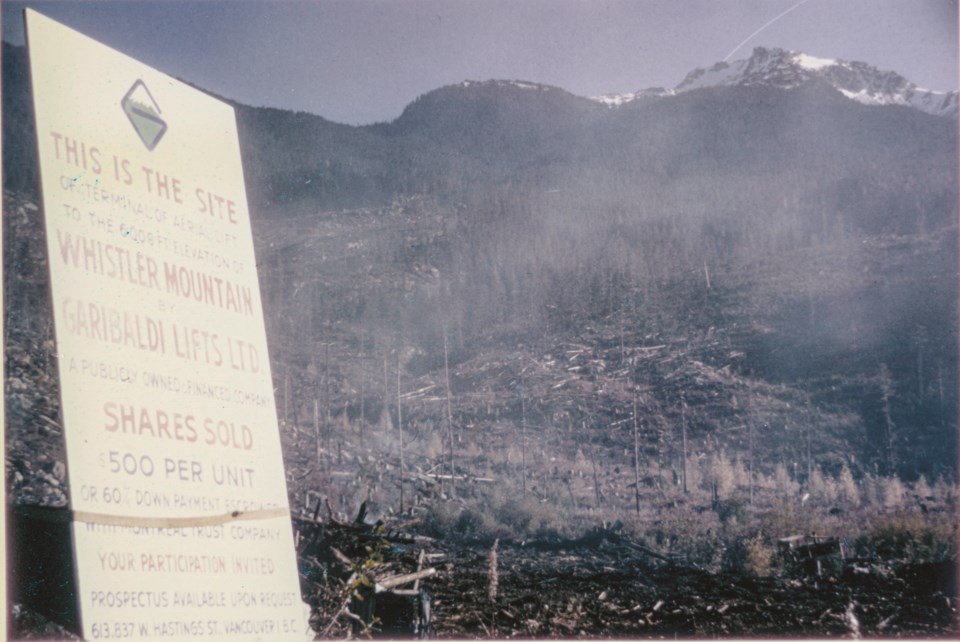Every day, people come into the Whistler Museum and are inspired to share their own stories. “I remember when I was looking at real estate in Whistler in the 1970s,” a visitor recently remarked. “Lots next to the garbage dump were selling for $10,000, but I was scared of bears, so didn’t buy one.”
That garbage dump is where Whistler Village now sits.
A recent favourite was when a longtime local told us about volunteering for a race on Whistler Mountain. One of the chairs fell from the Orange Chair, they recalled, and instead of stopping it and doing tests, volunteers were instructed to hide the chair in the trees so no one would see what had happened.
When Jim McConkey was visiting from Denman Island last year, he casually brought up how ski-boot designer Bob Lange brought him a prototype of a plastic lace-up ski boot to try, back when boots were exclusively made from leather. According to Jim, “I tried it and said, ‘You’re on the right track, but you’ve got to make a buckle boot.’ That was the first plastic boot there was.”
There are so many unique stories about Whistler and the people who call, or have called, this town home. Sixty years ago, there was no skiing on Whistler or Blackcomb mountains; instead, the valley was mainly used for logging and summer tourism, which revolved around fishing.
When Whistler Mountain first opened in 1966, visitors travelled to the lifts on a gravel road that was only plowed once a week. Whistler became a municipality less than 50 years ago, and when it was incorporated there was no sewer or municipal water in the valley, and many people relied on the manual collection of water from lakes or creeks.
Even more recent was the opening of the Whistler Mountain Bike Park. Most people would remember a time before the bike park, and Crankworx, now a global celebration of mountain biking, started in Whistler in 2004.
A lot has changed! We are regularly told the only thing in Whistler that hasn’t changed since opening are the lift lines. The Whistler Museum and Archives Society launched in 1986 to document these changes, so people could remember a time before skiing. Our mission is to collect, preserve, document, and interpret the natural and human history of mountain life, with an emphasis on Whistler, and to share this with the community to enrich the lives of residents and guests.
Like plenty of other Whistler institutions throughout history, the Whistler Museum is currently housed in a temporary trailer. The trailer that we call home started its life as Whistler’s Canada Post building in Creekside. In 1994 it was moved into the village, and the library occupied it until it found its own permanent home in 2008.
There are a few challenges with our temporary home. Preserving archives and artifacts for future reference and exhibits relies on specific temperature and moisture controls so materials do not degrade. The building that we have currently is hard to keep within these parameters. Storage space is also limited, so much of our collection is kept offsite in uncontrolled environments. This puts the collection at risk, and we would love to keep it under stricter conditions for improved protection, which we could do in a new museum.
A bigger footprint for the museum building will also mean we can share more of Whistler’s stories with the community. Whistler’s history is quite unique, and we have had an outsized global impact for such a small town—we want to be able to protect and celebrate this for generations to come.
On Dec. 6, the Resort Municipality of Whistler agreed to lease municipal land to the museum for a 60-year term to accommodate a new building. Sixty years ago, Whistler was not a ski town, and in another 60 years, who knows what will happen?
Whatever the future looks like, we hope the Whistler Museum will be around to capture and celebrate our history.
Look out for more exciting information related to a new museum facility in the coming months.



